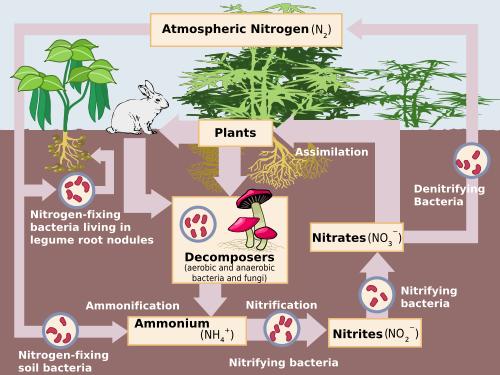Nitrogen (N) is an essential component of DNA, RNA, and proteins, the building blocks of life. All organisms require nitrogen to live and grow. Although the majority of the air we breathe is N2, most of the nitrogen in the atmosphere is unavailable for use by organisms. This is because the strong triple bond between the N atoms in N2 molecules makes it relatively inert, or unreactive, whereas organisms need reactive nitrogen to be able to incorporate it into cells. In order for plants and animals to be able to use nitrogen, N2 gas must first be converted to more a chemically available form such as ammonium (NH4+), nitrate (NO3-), or organic nitrogen (e.g., urea, which has the formula (NH2)2CO). The inert nature of N2 means that biologically available nitrogen is often in short supply in natural ecosystems, limiting plant growth.
Nitrogen is an incredibly versatile element, existing in both inorganic and organic forms as well as many different oxidation states. The movement of nitrogen between the atmosphere, biosphere, and geosphere in different forms is called the nitrogen cycle.
Different Nitrogen States
For Nitrogen to be used by different life forms on Earth, it must change into different states. Nitrogen in the atmosphere, or air, is N2. Other important states of nitrogen include Nitrates (N03), Nitrites (NO2), and Ammonium (NH4).
Nitrogen Cycle
This picture shows the flow of the nitrogen cycle. The most important part of the cycle is bacteria. Bacteria help the nitrogen change between states so it can be used. When nitrogen is absorbed by the soil, different bacteria help it to change states so it can be absorbed by plants. Animals then get their nitrogen from the plants.

Processes in the Nitrogen Cycle
- Fixation – Fixation is the first step in the process of making nitrogen usable by plants. Here bacteria change nitrogen into ammonium.
- Nitrification – This is the process by which ammonium gets changed into nitrates by bacteria. Nitrates are what the plants can then absorb.
- Assimilation – This is how plants get nitrogen. They absorb nitrates from the soil into their roots. Then the nitrogen gets used in amino acids, nucleic acids, and chlorophyll.
- Ammonification – This is part of the decaying process. When a plant or animal dies, decomposers like fungi and bacteria turn the nitrogen back into ammonium so it can reenter the nitrogen cycle.
- Denitrification – Extra nitrogen in the soil gets put back out into the air. There are special bacteria that perform this task as well.












